Crassula pellucida ‘Calico Kitten’ is a colorful succulent ideal for gardeners of any experience level. It is a trailing succulent, which makes it the perfect choice for hanging containers, ground cover, or as a ‘spiller’ in succulent arrangements or projects.
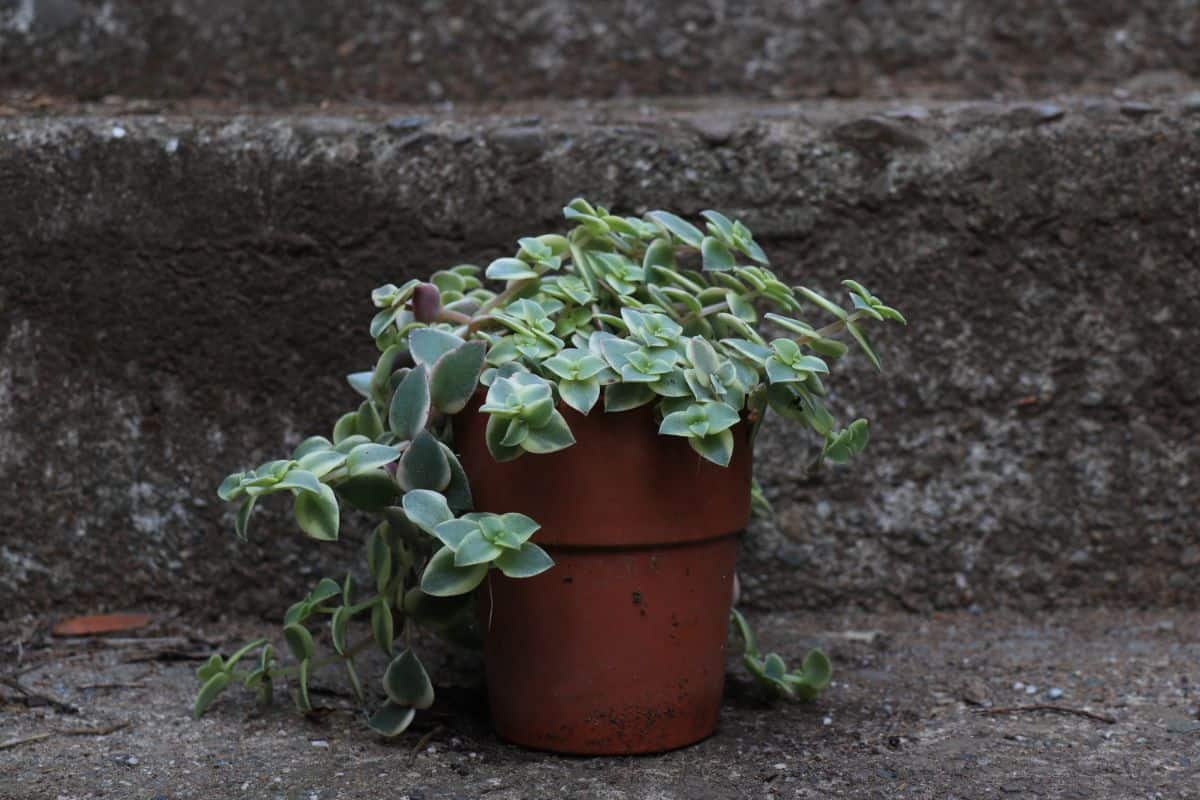
Calico Kitten is native to the Southern Cape region of South Africa, typically growing in shaded rocky or forest areas. It is the variegated form of Crassula pellucida marginalis.
Jump to:
Calico Kitten Appearance
| Name: | Crassula pellucida |
| Soil: | Well-draining soil |
| Blooming: | Spring |
| Light: | Bright light |
| Water: | When the soil is dry out |
| Propagation: | Stem cuttings, offsets and seeds. |
Calico Kitten is a trailing or creeping succulent with branch stems. It typically reaches about 6 inches in height at maturity. As the plant increases in height, the stems arc downward to create a ground covering or hanging effect. The stems themselves can measure up to 12 inches in length.
True to its succulent nature, the leaves of Calico Kitten are small and fleshy. As this is a variegated variety, the leaves are green and yellow striped. The leaf margins are a vibrant red, and the entire leaf can blush red with increased sunlight. The leaves are stacked in a fashion typical of many species of Crassula.
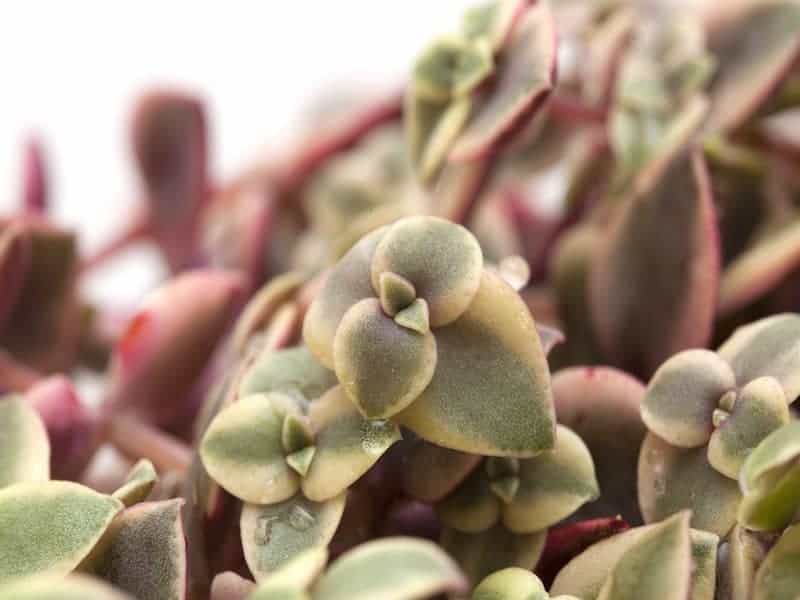
Buy it from:
Calico Kitten blooms in late spring or early summer and produces clusters of petite white flowers. The flowers are star-shaped and may also be off-white on some plants.
Caring for Calico Kitten
If you’re looking for an easy to care for succulent, look no further than Calico Kitten. As with most species of Crassula, this variety is a hardy plant that can forgive simple mistakes in care.
As with most succulents, Calico Kitten prefers a bit of neglect. However, as long as this succulent is provided with the basics, it should bless your garden with a splash of color for years to come.
Water
In typical succulent fashion, Calico Kitten enjoys being watered deeply but infrequently. It’s crucial to allow your Crassula’s soil to dry out between watering to prevent root rot.
Overwatering is the most frequent reason gardeners lose their Calico Kittens. Excess moisture for prolonged periods of time will eventually cause the root system to rot. Unfortunately, root rot is rarely noticed until it’s too late to save your plant.
No products found.
To prevent accidental overwatering, it’s crucial to water your succulents according to their needs rather than a set schedule. Though a schedule can be a helpful guide, succulent caretakers should check the soil moisture levels using a soil moisture meter or their finger before watering.
To check moisture levels, simply insert your finger or moisture meter into the soil. If the soil is too moist, the meter will alert you. If you’re using your finger, you’ll be able to tell if the soil still feels moist or wet to you.
If the soil is still moist, you’ll want to wait a few more days before watering to allow the soil to properly dry out. Remember to adjust your watering schedule during periods of extreme temperatures or changes in humidity.
Light
When grown indoors, Calico Kitten does best in bright indoor light. In most cases, an east or west-facing window is ideal. This is not a succulent that will thrive in a low-light environment, so be sure to place it near your sunniest window.
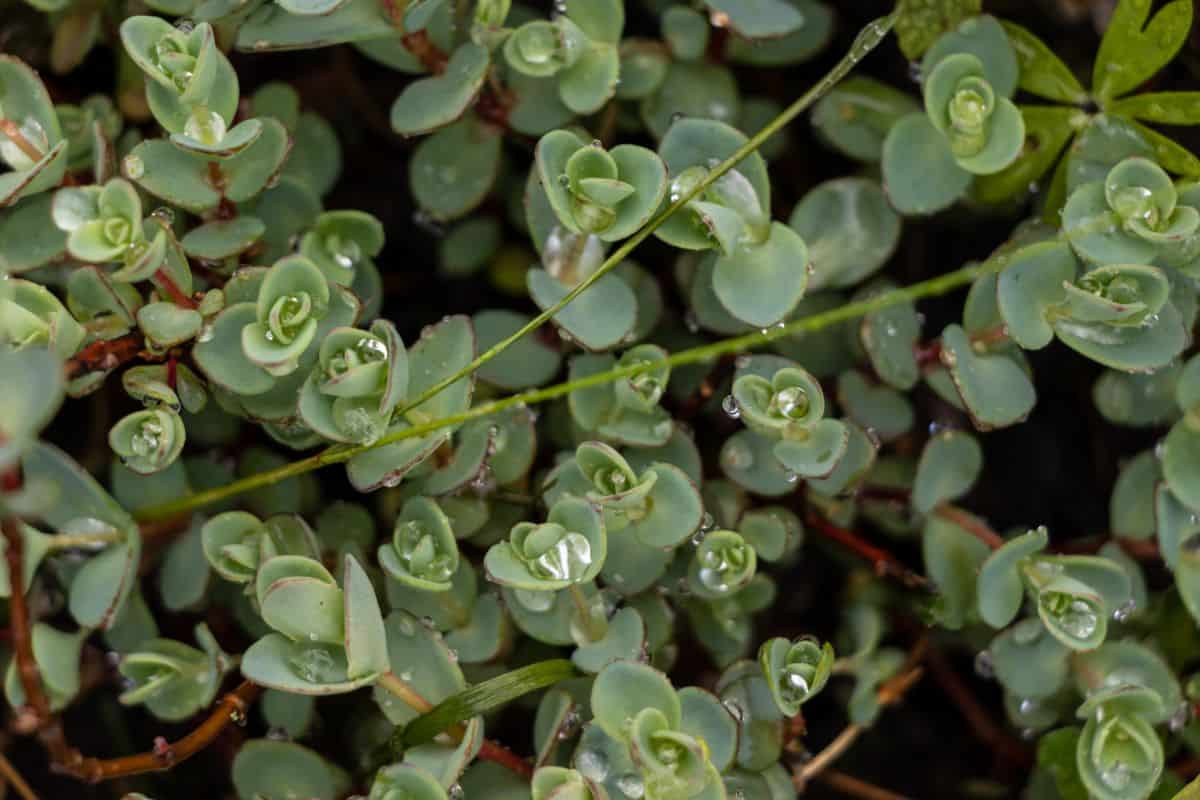
If your indoor space is unable to provide Calico Kitten with the right amount of sunlight each day, consider investing in a grow light. Grow lights are a great way to increase the amount of light without having to rearrange your home or office.
Grow lights come in a range of shapes and sizes to suit any indoor space. Most grow lights are also budget-friendly and will be beneficial to any other indoor plants you have near your Calico Kitten.
Without adequate light, your Calico Kitten can become stretched out or etiolated. While this won’t hurt your plant, many gardeners find it unsightly. Read more about etiolation here.
If you plan on growing Calico Kitten outdoors, be sure to plant it in an area where it will be protected from the sun during the hottest time of the day. Though this plant enjoys plenty of sunlight, full sun can result in sunburn.
Unfortunately, a sunburned plant cannot be repaired. You’ll either need to accept your succulent’s new appearance or trim away the damaged areas. With time, the damaged sections will be replaced with new growth.
To prevent sunburn, be sure to increase your Calico Kitten’s light levels slowly over a period of several weeks. By slowly increasing light, you’ll give your succulent time to adapt, which will help prevent the cosmetic damage caused by sunburn.
Temperature
Calico Kitten prefers warm environments and will not tolerate freezing temperatures. This is not a frost-hardy plant and it should be protected or brought inside any time temperatures dip below freezing.
If grown indoors, extreme or sudden changes in temperature are unlikely to be much of a concern. However, it’s still a good idea to keep your succulent away from any area that may experience drafts.
Check Also: Calico Kitten (Crassula Marginalis Rubra) Succulent Care Guide
Soil
As with most succulents, proper soil is essential to the health and survival of your Calico Kitten. Well-draining soil will allow excess moisture to drain away from your succulents’ roots and help prevent root rot.
Soil containing larger particles of material such as perlite, coarse sand, gravel, or bark, will also prove your plant’s roots with necessary airflow.
Avoid using soil mixes containing large percentages of clay, peat moss, or coconut coir. Though these ingredients are fine in small amounts, large amounts can cause the soil to retain too much moisture.
If you’d rather not make your own soil mixture, look for a commercial soil formulated for use with cacti and succulents. In general, these types of soil will provide your Calico Kitten with the drainage and aeration necessary for it to thrive.
It should also be noted that you should never line the bottom of your pot with rocks. Though this is a common method recommended to gardeners, it actually creates a perched water table. The perched water table raises the water level closer to your plant’s roots, rather than allowing it to drain away.
Container
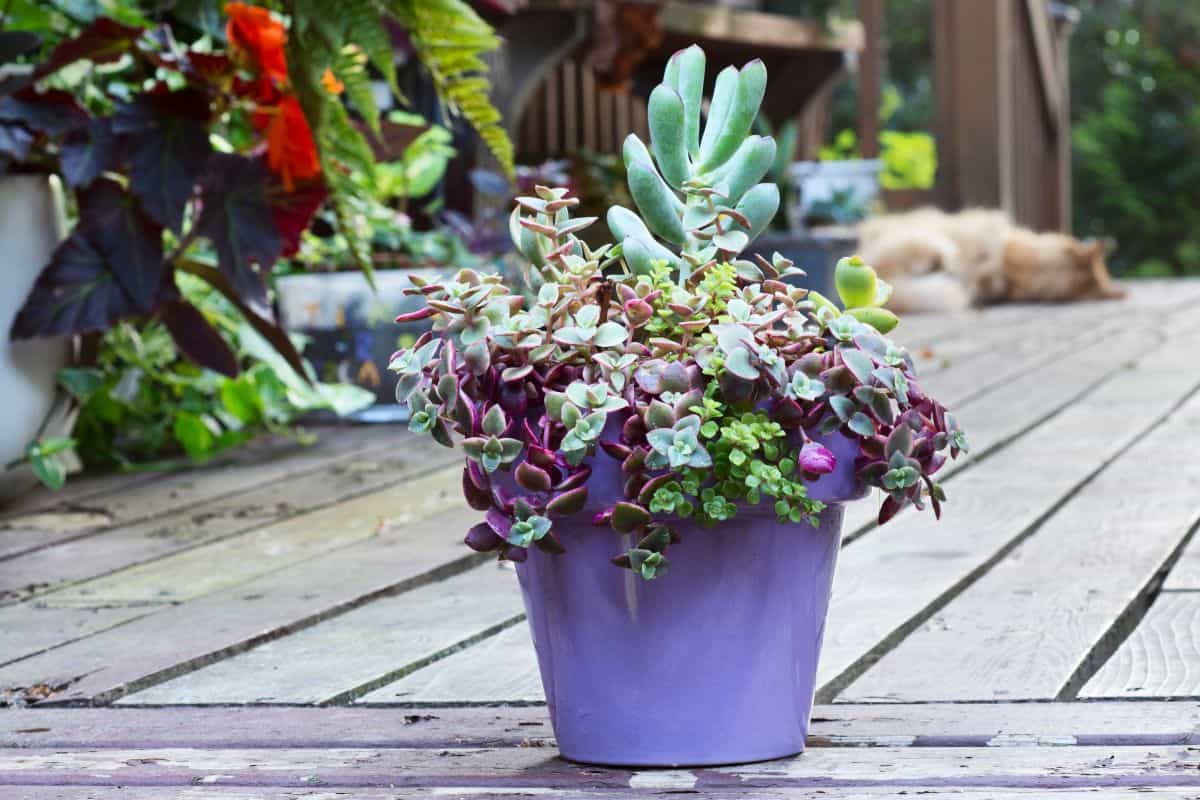
Though the type of pot you choose doesn’t matter, it’s important to consider the container’s drainage capabilities. Plastic and terracotta pots are the most common choices but be sure to choose a pot with a drainage hole.
Caring for succulents without a drainage hole is much more difficult and you need to be incredibly precise about your watering habits. Otherwise, you risk accidental overwatering.
Since Calico Kitten is a trailing succulent, consider planting it in a hanging container. Hanging containers are a great way to make use of vertical space and showcase your succulent’s long, draping stems.
Propagating Calico Kitten
As with most Crassula, Calico Kitten is incredibly easy to propagate. Regardless of your experience with succulent propagation, this can be a fun way to add more succulents to your collection or share your favorite succulent with friends and family.
See Related Article: Crassula Capitella Campfire Succulent Care Guide
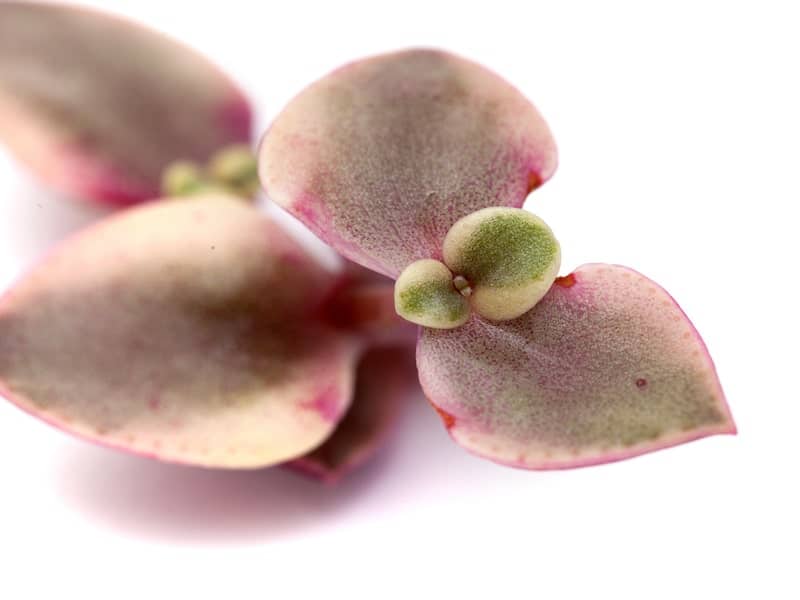
Offsets
The easiest method of Calico Kitten propagation is offset separation. Offsets, or pups, are the baby plants that pop up around the base of the mother plant.
This is a simple propagation method for gardeners of any experience level because the mother plant has done most of the work for you already. You just have to find a new home for the baby plants.
Offsets can be separated by gently tugging them while holding them at the base of the stem. Be gentle so as to preserve as much of the existing root system as possible.
Offsets may also be cut away using a sharp, clean knife. Just be sure to cut as close to the mother plant as possible without damaging the stem or roots.
Once separated, your Calico Kitten offsets need to sit out for a few days before planting. This gives the wounds a chance to callous, which will help prevent infection once it’s introduced to new soil.
After the wounds have calloused, the offsets are ready to be planted. Once you have them in a container with succulent approved soil, you can treat them just as you would any other Calico Kitten.
Cuttings
Stem cuttings are another super easy propagation method. It’s also a great way to make use of any cuttings you take while pruning your existing Calico Kitten. Take several and plant them all in the same pot for a fuller effect.
When taking cuttings, be sure to use sharp, clean scissors or shears to help minimize damage to your plant and increase your chance of success.
As with offsets, you’ll need to give your cuttings a few days to callous before you can introduce them to soil. You might also consider using rooting hormone powder to encourage faster root growth.
Once the cuttings have calloused, you can plant them in soil and wait for roots to appear. If you’re feeling particularly adventurous, you might also want to try water propagation.
After new roots have sprouted from your cuttings, you can treat them just as you would a mature Calico Kitten.
Seeds
A less common method of Calico Kitten propagation is to grow your succulents from seeds. This can be a fun experiment, but it is time-consuming, and you should not expect a mature plant any time soon.
Remember, succulents grow quite a bit slower than many other types of plants, so growing them from seeds requires a lot of patience. Calico Kitten is definitely not one of the slowest growing succulents, but it’s not exactly fast either.
To grow Calico Kitten from seeds, you’ll either need to collect seeds from your existing plants or purchase them. Most succulent seeds can be purchased online from reputable seed vendors.
Once you have the seeds in your possession, you’ll need to sow them in well-draining, moist soil. Make sure the seeds are covered, but not too deeply.
Keep the soil moist, but not wet until the seedlings sprout above the surface of the soil. Overly wet soil can cause the seeds to rot, but they need moisture to germinate.
After the seedlings have sprouted, you can allow the soil to dry out a bit and begin treating them like a more delicate version of a mature Calico Kitten.
If you’d like more information on growing succulents from seeds, be sure to read our guide.
Common Pests and Problems

In general, Calico Kitten is a healthy plant that isn’t overly prone to pests or disease. However, if pests are introduced to your garden, they will certainly make themselves among your Crassula.
The most common pests affecting Calico Kitten are spider mites, mealybugs, and aphids. As long as the infestation is caught early, these pests are relatively easy to treat. More serious infestations may take more time, but it’s not impossible to get rid of them.
The most important thing you can do for your succulents is to prevent pest infestations in the first place. As the saying goes, prevention is the best medicine. If you can make sure that pests don’t take over your garden in the first place, you won’t need to worry about eradicating them.
The first step in preventing pests is to quarantine any new plants you bring home. Keep them away from the rest of your plants for a minimum of two weeks. This will give any pests enough time to show themselves so you can treat just the new plants instead of your entire collection.
Even though succulents like Calico Kitten do not require daily care, it’s still important to check them on a regular basis. The sooner you notice any problems and address them, the better your plant’s chances at survival.
Good plant hygiene is also a crucial step in preventing pests. Most pests enjoy warm, damp conditions with plenty of dead plant material to feed on.
By following proper succulent watering procedures and cleaning up any dead or damaged leaves, stems, and debris, you’ll make your garden less inviting to any insect visitors.
Of course, even the most meticulous gardener will face pests at some point, but doing what you can to prevent them will make the treatment process much easier.


